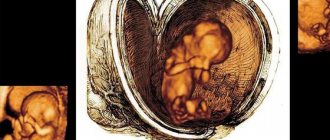Baby at 30 weeks of pregnancy
Every week the baby’s body becomes more and more adapted, which indicates its preparation for birth. All systems have been formed; over the next 10 weeks they will change slightly, improving their functions.
So, at the 30th week of pregnancy, the fetus makes breathing movements. This is necessary so that the muscles gain strength and participate in the act of breathing after the birth of the child. The baby swallows amniotic fluid, which sometimes leads to hiccups. At the same time, the lungs are still not quite ready for the first breath. In order for the alveoli (vesicles at the ends of the bronchioles of the pulmonary tree in which gas exchange occurs) not to stick together during breathing, they must have the required amount of surfactant, which is still not enough at 30 weeks.
A child at 30 weeks of gestation looks practically no different from a newborn, but he still has soft ear cartilage and significantly less subcutaneous fat. Although it should be noted that the baby’s body is already able to carry out thermoregulation to some extent due to the development of adipose tissue.
The baby's nervous system is actively developing. Convolutions continue to form in the brain, subcortical centers are improved, and the number of nerves increases. It is believed that the baby’s brain during this period can remember the received information. For example, if some external stimulus causes fear for the first time, then when it is repeated further, the child will react much calmer, since this factor will no longer be something new for him.
The baby’s weight at 30 weeks of pregnancy is 1500 g, and his height is 40-41 cm. Now the baby will begin to gain weight faster; the gain can be about 250 g per week. The heart rate still fluctuates between 120 and 140 beats per minute.
Week 30
Your baby is the size of a winter melon
Breech presentation at 30 weeks of pregnancy
The baby is not yet completely limited in his movements, so there is a high probability that towards the end of pregnancy he will take the desired position. Despite this, pregnant women who are diagnosed with breech presentation of the fetus are under the supervision of a gynecologist. The doctor may recommend special exercises that will help the baby roll over more quickly.
Weight gain
The optimal weight gain for women of normal build in the second half of pregnancy is about 250–300 g per week. Total weight gain at the end of week 30 is approximately 9.3 kg. Did you score more? Don’t worry, don’t try to lose weight on your own and don’t go on a diet (this can harm your baby!), but be sure to consult with your doctor - he may prescribe special fasting days for you during pregnancy. Did you score less? Don’t be upset either - as a rule, this is typical for women who are overweight to the point of “interesting position”. This state of affairs, however, does not exclude the need to consult with a good specialist as soon as possible and, if necessary, take the necessary measures to improve your condition.
Changes in the body of the expectant mother
The closer the due date, the more a woman’s body changes. At week 30, not only the pregnant woman’s belly has grown, but her hips and sides have also noticeably rounded, and the contours of her face have changed. It becomes increasingly difficult to stand on your feet and move for a long time; various painful sensations and swelling may bother you. Sudden changes in mood, caused by the production of large amounts of hormones, again accompany the expectant mother.
Belly at 30 weeks pregnant
By this time, many women note that their stomach has grown so much that it even puts pressure on the ribs. This is due to an increase in the size of the uterus, the height of the fundus of which is already 10 cm above the level of the navel. From time to time, a pregnant woman may experience a variety of sensations in the abdominal area. Pain on the right or left indicates stretching of the ligaments that support the uterus, and contractions of the uterus, which are not accompanied by pain and quickly pass, indicate the preparation of the uterus for the upcoming birth process. Training contractions are also called Braxton-Hicks contractions. If a woman notices that they do not stop, are accompanied by painful sensations and the appearance of specific discharge, she should call an ambulance.
Photos of bellies at the thirtieth week of pregnancy:
Previous Next
Small belly at 30 weeks pregnant
Sometimes gynecologists are concerned about the appearance of the expectant mother’s belly. Indeed, in some cases this may indicate oligohydramnios or a delay in fetal development. But if on an ultrasound all indicators are normal, and the height of the uterine fundus and abdominal circumference do not differ much from normal sizes, then there is no need to worry. After all, each woman has individual body parameters, each baby develops in its own way, which is why visually pregnant women differ from each other. If pathologies are confirmed, the doctor will prescribe appropriate treatment and strengthen control over the condition of the expectant mother.
For many couples, photographs of pregnant women at different stages are a pleasant memory. To remember how your belly has changed at 30 weeks of pregnancy, you should take a photo today.
Discharge at 30 weeks of pregnancy
By this time, expectant mothers get used to the presence of discharge. With the advent of the mucus plug, their number has increased slightly, but their character should not change. Normal discharge during pregnancy has a uniform consistency, a slight sour odor and a whitish tint (or it is odorless and transparent). Any deviation from the norm should cause concern in a woman, since they are a sign that there are some pathological processes in the woman’s body. In this case, you should immediately visit your doctor. And if the discharge contains blood, call an ambulance.
Body changes and new sensations for women
If we say that now mothers are enjoying their position to the fullest, we, of course, are lying.
Women at 30 weeks are very tired, every day it becomes more and more difficult for them to carry a child under their hearts. What to do? Learn to ignore difficulties and prepare yourself for the fact that the third trimester will soon end, and a meeting with your beloved baby awaits you ahead! Continue to monitor your health during the 30th week and follow all the safety measures necessary during this period. In particular, avoid resting on your back. Otherwise, you risk causing yourself compression syndrome by the uterus of the inferior vena cava, which runs along the right side of the spine. This may result in headaches, dizziness, or a feeling of shortness of breath. Another consequence of the syndrome is an increase in blood pressure in the veins of the lower extremities, as well as in the hemorrhoidal veins located under the skin near the anus, which leads, accordingly, to varicose veins of the legs and hemorrhoids. So how to sleep during pregnancy? Remember: the expectant mother can only rest on her side, preferably on the left.
Ultrasound at 30 weeks of pregnancy
During the entire period of pregnancy, the pregnant woman undergoes three ultrasound examinations. The first two should have been done at their due date, and the third ultrasound is performed from 30 to 34 weeks of pregnancy. This time, the woman will no longer be able to see her baby in full growth, since he has grown, but his internal organs will be visible.
During this examination, the ultrasound specialist will determine all the necessary dimensions of the fetus and determine the gestational age according to them. The maturity of the placenta, the amount of water and the condition of other pelvic organs of the pregnant woman are also assessed. If necessary, an ultrasound is performed with Doppler to assess fetal blood flow and rule out possible problems.
Necessary studies and tests at 30 weeks of pregnancy
Every two weeks, pregnant women undergo a general urine test, the results of which will be available to the gynecologist at the time of their appointment. Also, at week 30, a woman may be prescribed blood tests: CBC, blood test for sugar, Rh factor, and diseases such as HIV. This week the woman is being examined again by specialists. For example, an ophthalmologist will evaluate the condition of the visual analyzer and tell you whether a woman can give birth naturally or whether she will have to undergo a cesarean section.
This week, a pregnant woman may be prescribed CTG - fetal cardiotocography, which will show how the baby’s heart works. Sometimes this study helps to identify any pathologies, which will be an indication for emergency delivery of the pregnancy.
At 30 weeks, all women receive a certificate of incapacity for pregnancy and childbirth for 140 calendar days. In other words, starting this week they are going on maternity leave. In case of multiple pregnancy, a woman receives such a certificate 2 weeks earlier and her leave period is 196 days.
Possible problems
At this stage, a pregnant woman, as before, may be accompanied by pain, fatigue, problems with the digestive system (heartburn, constipation), and headaches. It is worth saying that towards the end of pregnancy, some women even get tired of their situation and look forward to giving birth.
Childbirth at 30 weeks of pregnancy
Even with a normal pregnancy, there is a risk of premature birth, and if there are any abnormalities or risks, the likelihood that they can occur increases. Unfortunately, pregnant women are not immune from sudden falls; not everyone can afford to give up excessive physical activity, and stress sometimes has a greater impact.
At the 30th week of pregnancy, the baby’s organ systems are not yet perfect, so when he is born, he will be under the supervision of doctors for some time in special conditions, but his chances of survival are already quite high.
Soft cervix during pregnancy 30 weeks
The cervix is a kind of support for the uterus itself with the child growing in it. Therefore, doctors monitor her condition throughout pregnancy. Softening of the cervix at this stage is a dangerous sign, indicating the possibility of premature birth. Normally, the cervix should become soft closer to childbirth. Moreover, such a change may be accompanied by a shortening of the cervix, which should be at least 3.5 cm in length. When the doctor sees such changes at 30 weeks, he can refer the pregnant woman for preservation to the pregnancy pathology department, which should not be refused. In general, when such symptoms appear, a woman needs to exclude physical activity and stress factors, and often rest, placing a pillow or bolster under her pelvis.
Low placentation during pregnancy 30 weeks
During pregnancy, the position of the placenta may change as the lower part of the uterus also changes. There is a very small percentage of women who, at the time of birth, still have a low-lying placenta, which is an indication for delivery by cesarean section. If at this stage you are diagnosed with low placentation, do not worry ahead of time. Follow the same recommendations as when softening the cervix: no physical activity (you can take short walks), sufficient rest in a lying position with a pillow placed under the pelvis.
Moderate oligohydramnios during pregnancy 30 weeks
Oligohydramnios during pregnancy is a great threat to the life of the baby, however, some experts say that moderate oligohydramnios indicates a decrease in the amount of water to the lower level of normal values, which should not frighten the pregnant woman much. There are many reasons, as well as complications, for this phenomenon, but it is important to understand one thing: when such a problem is identified, the woman needs to strictly follow all the recommendations of the gynecologist. This includes regular ultrasound with Doppler and CTG, and drug treatment. Under the supervision of competent specialists, a pregnant woman safely carries her baby and can give birth without complications.
Cold at 30 weeks of pregnancy
When a woman is pregnant, her body reduces the level of immune defense so that its cells do not harm the fetus. At the same time, there is a danger in the form of various infections, of which the most common is the common cold. Treatment for a cold during pregnancy is different from the treatment we are all used to. Many medications should not be used because they affect the fetus. Therefore, all that remains is to deal with the symptoms.
It is advisable to spend time at home before recovery, resting more, so that the body finds the strength to fight the disease. Drink enough fluids to flush out toxins. If you have a runny nose, rinse your nose with saline solutions, and rinsing with herbal infusions will help reduce a sore throat. If the temperature rises to 38 degrees or higher, you can take a paracetamol tablet as an antipyretic. In any case, only a doctor can prescribe adequate treatment, so you should definitely consult with him about your disease.
Lifestyle
The time has come when you can and should prepare for childbirth. In particular, it is necessary to activate the muscles that make it easier for the baby to move through the birth canal. In this regard, a set of exercises developed by the American gynecologist Arnold Kegel is very effective. The point of Kegel exercises for pregnant women is to alternately tense and relax the muscles of the perineum. First of all, we are talking about the pubococcygeus muscle. Finding it in yourself is quite simple: when you want to go to the toilet “in a small way”, sit on the toilet, spread your legs and begin the “process”. As you go, try to stop the stream without moving your legs. You yourself will feel which muscle will tense the most - you need to work with it. The pubococcygeus muscle should be squeezed and unclenched in any position (about 10 repetitions) at least 5 times a day.
Recommendations
- Flying at 30 weeks of pregnancy. The need to fly on an airplane during pregnancy raises many questions. Many women boldly fly. However, it is worth knowing about contraindications for flying. You can read about this in detail in our article about the 28th week of pregnancy.
- Nutrition at 30 weeks of pregnancy. It, as before, should be balanced in proteins, fats and carbohydrates, and the pregnant woman’s menu should contain a sufficient amount of fiber. To prevent the development of edema, you need to slightly reduce the amount of all liquid consumed (in addition to water, you should consider the amount of milk, tea, fruit drink, etc.) and salt. To avoid large weight gains, a woman needs to moderate her appetite and refuse to eat smoked and sweet foods, her favorite baked goods and various harmful foods. It is also worth not frying food, but steaming or boiling it.
- You need to pay attention to clothes and shoes. Wardrobe items should under no circumstances restrict a pregnant woman’s movements or put pressure on her stomach. It is better to choose shoes that are comfortable and without heels.
- At such a time, you need to be careful with physical activity so that it does not provoke premature birth. But there is no need to give up walking in the fresh air.
- It should be clear to all family members that a pregnant woman should not overburden herself with household responsibilities, even if she is on maternity leave. She, on the contrary, now needs to rest more, because her body is getting more and more tired closer to childbirth. When going to bed, the expectant mother should avoid the “lying on her back” position, since the uterus can put pressure on the inferior vena cava, which can affect not only the pregnant woman herself, but will also contribute to the appearance of hypoxia in the fetus.
- Communication with the baby will not only calm the expectant mother and lift her spirits. It also affects the development of the child, who needs to hear his mother’s voice. You can read fairy tales, sing songs, talk to the baby. Classical music and special music for babies also have a positive effect on the baby.
Beauty and accessories
During pregnancy, the legs suffer greatly, as they bear a “double load”! Special compression tights for expectant mothers will help your legs - wearing them is rightfully considered one of the most effective ways to prevent varicose veins, as well as heaviness in the legs and swelling while waiting for the baby. Compression tights are made from medical knitwear; they do not compress the stomach and waist and are perfect for everyday wear. You can buy them at the pharmacy. However, before purchasing, we recommend that you consult with a specialist.









